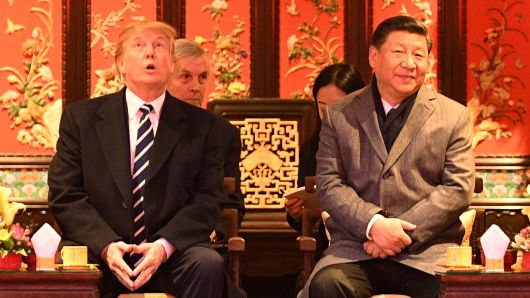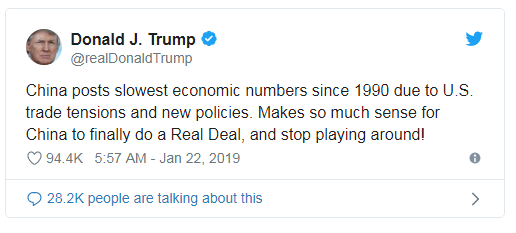Analysts see 'several signs of modest progress' in latest US-China trade talks
In the wake of the latest round of trade talks between officials from Washington and Beijing, outside observers are noting that some progress appears to have been made — but there's still a long way to go before a meaningful deal.

On Wednesday, the U.S. trade delegation released a statementnoting a long list of outstanding issues in the relationship between the world's two largest economies — including "forced technology transfer, intellectual property protection, non-tariff barriers, cyber intrusions and cyber theft of trade secrets for commercial purposes, services, and agriculture."
Still the official statement also recognized that China had pledged to buy "a substantial amount of agricultural, energy, manufactured goods, and other products and services" from the U.S. Some analysts said that language, in addition to the meeting extending to a previously unannounced third day, indicated some potential thawing in the dispute.
"There were several signs of modest progress from these mid-level talks. First, negotiations went a day over the original schedule, indicating enough substantive discussion to at least keep officials at the table. Day three reportedly focused on the more knotty structural issues raised by the US side in detailed demands presented to Beijing in May 2018," a group of experts from political risk consultancy Eurasia Group wrote in a Wednesday note.
They added: "Second, (the U.S. Trade Representative's) statement noted that China has pledged to purchase a 'substantial amount' of US exports, including agriculture, energy and manufactured goods. That language suggests that, as we expected, Beijing is carrying out a strategy of aggressively purchasing US goods — playing to (U.S. President Donald Trump's) focus on reducing the trade deficit — in the hopes that it lessens the pressure on China to undertake difficult structural measures."
China, for its part, said in a Thursday morning statement issued by its Commerce Ministry that the just-concluded round of trade talks with the U.S. were extensive and established a platform for future discussions.
"Both sides ... held broad, deep and meticulous discussions on shared observations on trade issues and structural problems, laying the foundation for addressing areas of common concern," the statement said, according to a CNBC translation of the original Chinese.
Even before the talks were extended into a third day, the analyst community was already seeing a positive sign when China's top trade negotiator, Liu He, reportedly stopped by the negotiating room on Monday. Given the vice-ministerial level of the talks, that was interpreted as a strong signal that Beijing was taking negotiations seriously.
In early December, Trump and Chinese President Xi Jinping agreed to a temporary ceasefire, giving both sides until March to reach some agreement on trade and issues such as the forced transfer of technology.
Trade tensions between the world's two largest economies escalated last year, putting global markets on edge. The U.S. announced tariffs on $250 billion worth of Chinese goods, while Beijing countered with its own battery of levies.
Both parties, the Beijing ministry said, agreed to maintain close contact.
In response to the U.S. statement on the talks, U.S.-China Business Council President Craig Allen said in a release that his group was "pleased that the two governments had substantive discussions over the past three days."
Still, he noted that the business community is concerned about more than just the overall balance of trade between the two economic superpowers — a problem that is at least partially addressed by Beijing's pledge to purchase more U.S. goods and services.
"We urge both governments to use the time remaining in the 90-day negotiating period to make tangible progress on the important issues at the core of the current dispute: equal treatment of foreign companies in China, as well as China's intellectual property and technology transfer policies," Allen said.
Beijing has denied that it forces foreign companies to transfer technology to Chinese parties in exchange for market access, but it has in various ways acknowledged that it could do more to allow overseas players an equal footing within its borders. To what extent such reforms are truly on the Communist Party's agenda remains a matter of debate.
Another "elephant in the room" in the trade relations between China and the U.S. is additional tariffs that both countries have imposed on each other's products, said Eric Robertsen, head of global macro strategy at Standard Chartered.
"Now, trade is only one part of this, the bigger picture issues around intellectual property, forced sharing of technology et cetera I don't think those get addressed in the short term," Robertsen told CNBC's "Squawk Box" on Thursday.
"Remember, the thing that we have to solve for is getting to the end of the negotiating period and making sure that enough progress has been made so that tariffs not lifted, we still have that elephant in the room of tariffs," he added.
Market reactions
Asian markets were mostly lower on Thursday after the end of the latest U.S.-China trade talk. Stock markets globally rallied earlier in the week on optimism that both countries were making progress on trade.
"Markets have been quite optimistic about this trade talk, so that's why we're seeing some profit-taking after the rally. I think the result was pretty much as expected so people are not too excited and they probably will look forward to another meeting," Alex Wong, director of asset management at Ample Capital, told CNBC's "Squawk Box."
在线留言询价

Pushing the boundaries of semiconductors
- 一周热料
- 紧缺物料秒杀
| 型号 | 品牌 | 询价 |
|---|---|---|
| RB751G-40T2R | ROHM Semiconductor | |
| MC33074DR2G | onsemi | |
| CDZVT2R20B | ROHM Semiconductor | |
| BD71847AMWV-E2 | ROHM Semiconductor | |
| TL431ACLPR | Texas Instruments |
| 型号 | 品牌 | 抢购 |
|---|---|---|
| BP3621 | ROHM Semiconductor | |
| ESR03EZPJ151 | ROHM Semiconductor | |
| STM32F429IGT6 | STMicroelectronics | |
| TPS63050YFFR | Texas Instruments | |
| IPZ40N04S5L4R8ATMA1 | Infineon Technologies | |
| BU33JA2MNVX-CTL | ROHM Semiconductor |
- 周排行榜
- 月排行榜
AMEYA360公众号二维码
识别二维码,即可关注























